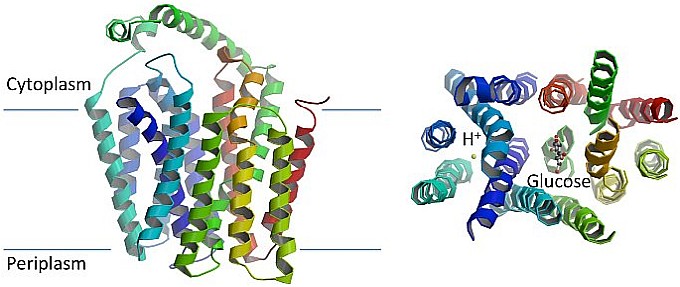Glucose transporters are required to bring glucose into cells, where it is essential as an energy source, and as a precursor in protein and lipid synthesis. In humans, 14 members of the glucose transporter (SLC2A or GLUT) family have been identified and share significant sequence homology, but they vary in substrate specificity and affinity, tissue expression, and type of transport (uniport, proton symport, or facilitated diffusion), presumably to suit tissue-specific physiological demands. These transporters have been implicated in cancer and in diabetes. In numerous cancers, there are increased levels of certain GLUTs that are absent or are at low levels in normal cells. Thus, employing GLUTs as therapeutic targets requires understanding of the functional variability among GLUT members, so that the activity of a particular GLUT can be affected while minimally disrupting that of other GLUTs. To determine the structural basis of the functional diversity among glucose transporters, the Choe group targeted human GLUTs and bacterial homologues for protein crystallization. They successfully crystallized a transporter from Staphylococcus epidermidis (GlcPSe), which has high affinity and specificity for glucose and is inhibited by known human GLUT inhibitors. GlcPSe is a proton symporter, similar to human GLUT12 and GLUT13. The ligand-free structure of GlcPSe, in the inward-facing conformation, along with mutagenesis and functional studies led to identification of the proton-binding site and of key residues that could switch the glucose transport from symport to uniport. They proposed a mechanism for glucose/H+ symport and discussed the symport mechanism versus facilitated diffusion.
 |
Figure: Inward-facing conformation of GlcPSe: side-view (left) and top view (right) showing the relative location of the putative proton- and glucose-binding sites. |
Citation: Iancu CV, Zamoon J, Woo SB, Aleshin A, Choe JY. Crystal structure of a glucose/H+ symporter and its mechanism of action. Proc Natl Acad Sci U S A. 2013 October 29; 110:17862-17867.